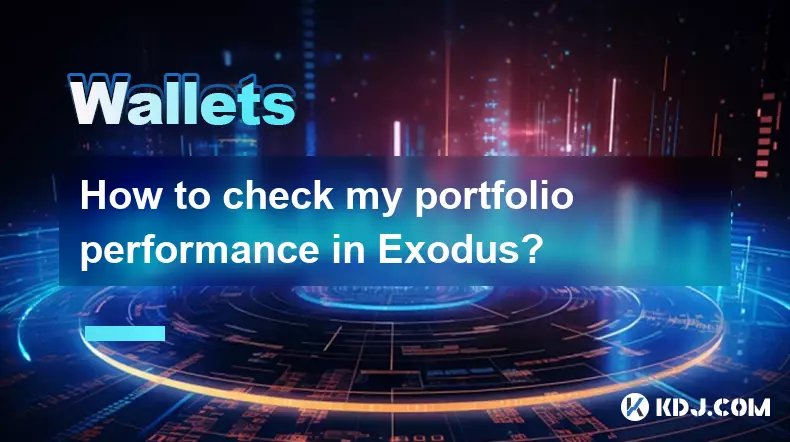-
 bitcoin
bitcoin $112195.049338 USD
2.42% -
 ethereum
ethereum $4124.915858 USD
2.81% -
 tether
tether $1.000570 USD
0.02% -
 xrp
xrp $2.861568 USD
2.25% -
 bnb
bnb $1000.346670 USD
3.04% -
 solana
solana $209.070819 USD
3.38% -
 usd-coin
usd-coin $0.999870 USD
0.02% -
 dogecoin
dogecoin $0.235379 USD
2.65% -
 tron
tron $0.335681 USD
-0.20% -
 cardano
cardano $0.803501 USD
3.38% -
 hyperliquid
hyperliquid $47.120881 USD
3.56% -
 chainlink
chainlink $21.501300 USD
3.44% -
 ethena-usde
ethena-usde $1.000571 USD
0.02% -
 avalanche
avalanche $29.793378 USD
3.62% -
 stellar
stellar $0.366964 USD
2.42%
How to check my portfolio performance in Exodus?
Access your Exodus portfolio dashboard to view real-time asset values, performance trends, and historical charts across all supported cryptocurrencies.
Sep 17, 2025 at 02:37 am

Accessing Your Portfolio Dashboard in Exodus
1. Launch the Exodus application on your desktop or mobile device. Ensure you are logged into your wallet using your password or biometric authentication if enabled. Once inside, the main interface displays your portfolio summary, including total balance across all supported assets.
2. Locate the 'Portfolio' tab at the bottom of the mobile app or on the left-hand sidebar in the desktop version. Clicking this section brings up a comprehensive view of your holdings, showing each cryptocurrency’s current value, percentage of portfolio, and recent price movements.
3. The dashboard automatically aggregates data from all your connected accounts within Exodus. This includes Bitcoin, Ethereum, USDC, and other integrated tokens. No manual syncing is required as the app pulls real-time market data to reflect accurate valuations.
4. To view performance over time, tap or click on the graph icon usually located near the total balance display. This opens a historical chart that allows you to switch between different timeframes such as 24 hours, 7 days, 1 month, or 1 year.
Understanding Performance Metrics
1. The performance chart illustrates how your total portfolio value has changed across selected periods. Green trends indicate growth while red indicates decline. Hovering over or tapping specific points reveals exact values on those dates.
2. Each asset in your wallet contributes to overall performance. You can isolate individual coins by selecting them from the list. This shows their standalone price history and how they’ve appreciated or depreciated independently.
3. Exodus pulls live exchange rates from multiple sources to ensure accuracy in valuation and performance tracking. These rates update frequently, typically every few minutes, depending on market activity.
4. Percentage changes are displayed next to each asset, indicating gains or losses since your last transaction or over the past 24 hours. These figures help identify which holdings are driving portfolio movement.
Exporting and Analyzing Data
1. While Exodus does not currently offer a direct export function for portfolio history, you can manually record snapshots using screenshots or external note-taking tools. Regular logging enables personal analysis outside the app.
2. For deeper insights, transfer your transaction history to a spreadsheet. Copy details such as date, asset type, amount, and value at the time of transaction. Use this data to calculate cost basis, profit/loss, and allocation shifts over time.
3. Integrating Exodus with third-party portfolio trackers like CoinTracker or Koinly requires importing transaction data via CSV files from connected exchanges, not directly from Exodus. Manual entry may be necessary for full accuracy.
4. Keep in mind that Exodus focuses on user experience and simplicity rather than advanced analytical tools. Users seeking detailed tax reporting or complex performance breakdowns often combine it with external services.
Managing Multiple Devices and Backups
1. Portfolio performance remains consistent across devices when using the same Exodus wallet. Syncing occurs through your private key or recovery phrase, not cloud storage. Always restore using the 12-word phrase to maintain continuity.
2. If you access Exodus on multiple devices, ensure each one is updated and logged in securely. Performance data will reflect the same blockchain records regardless of entry point.
3. Never share your recovery phrase or attempt to restore your wallet on untrusted devices, as this compromises security and indirectly affects portfolio integrity.
4. Regularly verify that all transactions appear correctly across devices. Discrepancies could indicate syncing issues or unauthorized access, both of which impact performance assessment.
Frequently Asked Questions
Can I see my portfolio’s all-time high value in Exodus?Exodus does not display historical all-time highs for your total portfolio value. You can infer peak performance by reviewing the graph manually and noting maximum points during specific intervals.
Does Exodus show profit and loss based on my purchase price?No. Exodus does not track cost basis or calculate realized gains and losses. It only shows current market value and price changes over time without accounting for individual buy prices.
Why does my portfolio value fluctuate even when I don’t make transactions?Cryptocurrency prices are highly volatile. Even without activity, the value of your holdings changes based on real-time market conditions. Exodus updates balances accordingly using live data feeds.
Is there a way to set price alerts for my portfolio in Exodus?Exodus does not include built-in price alerts. However, you can monitor assets through the app regularly or use external platforms that support alert features for specific cryptocurrencies.
Disclaimer:info@kdj.com
The information provided is not trading advice. kdj.com does not assume any responsibility for any investments made based on the information provided in this article. Cryptocurrencies are highly volatile and it is highly recommended that you invest with caution after thorough research!
If you believe that the content used on this website infringes your copyright, please contact us immediately (info@kdj.com) and we will delete it promptly.
- Bitcoin, Ethereum, and Correction Concerns: Navigating the Crypto Seas
- 2025-09-30 08:25:12
- SWIFT, Consensys, and Blockchain Settlement: A New Era for Global Finance?
- 2025-09-30 06:25:13
- Andre Cronje's Flying Tulip Takes Flight with $200M Round: A New Era for DeFi?
- 2025-09-30 06:45:14
- SEC, CFTC, and Crypto Rumors: Harmonization Efforts and ETF Developments
- 2025-09-30 06:45:14
- Gold Dollar Coin, Mystery, Upright 5: Unearthing Hidden History and Whale-Sized Speculation
- 2025-09-30 06:25:13
- Meme Coins, Smart Money, 2025 Riches: Navigating the Hype
- 2025-09-30 06:30:01
Related knowledge

How do I view smart contract interaction history in Coinbase Wallet?
Sep 24,2025 at 01:36am
Accessing Smart Contract Interaction History in Coinbase Wallet1. Open the Coinbase Wallet application on your mobile device and log in using your cre...

How do I use the token swap feature in Coinbase Wallet?
Sep 24,2025 at 05:00pm
Understanding Token Swaps in Coinbase Wallet1. The token swap feature in Coinbase Wallet enables users to exchange one cryptocurrency for another dire...

How do I participate in governance voting in Coinbase Wallet?
Sep 25,2025 at 01:55pm
Understanding Market Volatility in the Crypto Space1. Cryptocurrency markets are known for their extreme price fluctuations, often driven by sentiment...

How do I set up a custom RPC node in Coinbase Wallet?
Sep 24,2025 at 12:00pm
Understanding Custom RPC Nodes in Coinbase Wallet1. A custom RPC (Remote Procedure Call) node allows users to connect their Coinbase Wallet to a block...

How do I manage multiple assets in Coinbase Wallet?
Sep 23,2025 at 10:00am
Understanding Multi-Asset Support in Coinbase Wallet1. Coinbase Wallet allows users to store a wide variety of digital assets beyond just Bitcoin and ...

How do I connect Coinbase Wallet to a hardware wallet?
Sep 26,2025 at 02:54am
Connecting Coinbase Wallet to a Hardware Device1. Open the Coinbase Wallet app on your mobile device and ensure it is updated to the latest version. N...

How do I view smart contract interaction history in Coinbase Wallet?
Sep 24,2025 at 01:36am
Accessing Smart Contract Interaction History in Coinbase Wallet1. Open the Coinbase Wallet application on your mobile device and log in using your cre...

How do I use the token swap feature in Coinbase Wallet?
Sep 24,2025 at 05:00pm
Understanding Token Swaps in Coinbase Wallet1. The token swap feature in Coinbase Wallet enables users to exchange one cryptocurrency for another dire...

How do I participate in governance voting in Coinbase Wallet?
Sep 25,2025 at 01:55pm
Understanding Market Volatility in the Crypto Space1. Cryptocurrency markets are known for their extreme price fluctuations, often driven by sentiment...

How do I set up a custom RPC node in Coinbase Wallet?
Sep 24,2025 at 12:00pm
Understanding Custom RPC Nodes in Coinbase Wallet1. A custom RPC (Remote Procedure Call) node allows users to connect their Coinbase Wallet to a block...

How do I manage multiple assets in Coinbase Wallet?
Sep 23,2025 at 10:00am
Understanding Multi-Asset Support in Coinbase Wallet1. Coinbase Wallet allows users to store a wide variety of digital assets beyond just Bitcoin and ...

How do I connect Coinbase Wallet to a hardware wallet?
Sep 26,2025 at 02:54am
Connecting Coinbase Wallet to a Hardware Device1. Open the Coinbase Wallet app on your mobile device and ensure it is updated to the latest version. N...
See all articles


























![[Pycoin] PI Coin -Shocking Listance of Pycoin?! 'Rebellion' This time ... Pay attention to #paikoin [Pycoin] PI Coin -Shocking Listance of Pycoin?! 'Rebellion' This time ... Pay attention to #paikoin](/uploads/2025/09/29/cryptocurrencies-news/videos/pycoin-pi-coin-shocking-listance-pycoin-rebellion-time-pay-attention-paikoin/68da82f23cec1_image_500_375.webp)















































